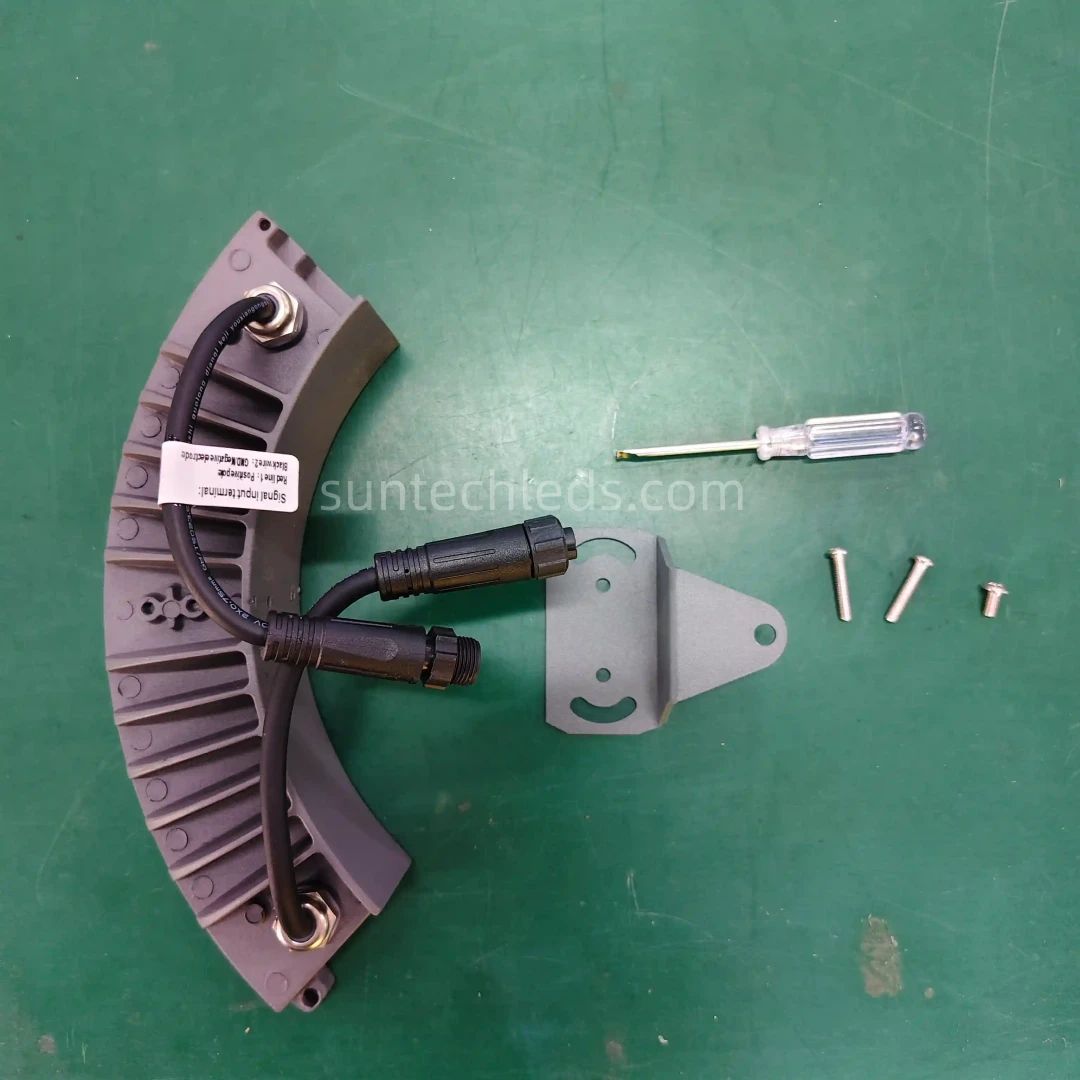English 


Views: 0 Author: Emma Publish Time: 2025-10-27 Origin: https://www.suntechleds.com/
Table of contents
Application Scenarios of Tree-hugging Lights
Benefits of Installing Tree-hugging Lights
Four Frequently Asked Questions about Tree-Hugging Lights
Tree hugger lights are mostly used to light up trees or other tall items in the landscape. As the name suggests, these hollow cylinder-shaped fixtures are made to wrap around tree trunks and place at the base to make it look like they are hugging the tree.
Typically, achieving uniform illumination for a single tree requires four floodlights. Replacing these with a single tree-hugging light suffices. When comparing the tree-illumination effects of both under identical power and color temperature conditions, a single tree-hugging light delivers noticeably superior results compared to four floodlights.
Tree hugger lights also offer superior coverage. When floodlights are placed directly on the ground, they can create a cluttered appearance, and their protruding fixtures detract from aesthetics. Leaf coverage may also cause light loss, resulting in unclear trunk definition. In contrast, tree-hugging lights emit light vertically upward or downward from beneath the tree. This illuminates the entire tree more brightly and evenly, making the canopy and tree shape clearly visible. At night, trees become more recognizable, with the trunk's form fully outlined, more authentically restoring the tree's natural appearance.
If you are looking for a cost-effective flexible LED tree-hugging light, you can click here. It is very suitable for use in the courtyard.I also recommend some related products to you:LED Underground Light, LED Flood Light.


Tape measure: Find out how big around the tree trunk is.
Screwdriver: Hold lights in place
Wire strippers: Get wires ready to join if necessary
Tree-hugging light mounting clips: Needed to put together tree-hugging lights
Waterproof tape: Keep exterior installations safe from rain
Cable ties: Keep extra wires neat
1. Measure the trunk's circumference to make sure the tree hugger light will fit.
2. Find out how high to put it. Most of the time, it's best to do it 30–50 cm above the base of the trunk. This keeps the ground from getting wet and makes sure that the main trunk area is well-lit.
3. Use a screwdriver to connect the light fixture bracket together, making sure that each clip is snug so that the electricity can flow through it. Put a layer of waterproof tape over the lamp connector when it's outside to keep rain from getting in.
4. If you're using a plug-in tree hugger light, connect it directly into an exterior outlet that won't get wet. For wired installations, connect the lamp wires' positive and negative ends to the power cord's matching ends. Before putting on a waterproof sleeve, use electrical tape to secure it in place.
5. Use cable ties to hold any extra wires along the gaps in the tree trunk or gently tie them to the back of the trunk. To keep it looking good, put it where it can't be seen whenever you can.
6. Adjust the angle of the fixture so that the vertical light covers the main trunk and the bottom canopy.
It is recommended to choose a waterproof rating of IP65 or above for the tree-hugging lamp. Please refer to this LED Strip IP20 VS IP65 VS IP67 VS IP54 VS IP68




Tree-hugging lights are pri marily used for decorative lighting of trees, commonly found in landscape lighting and atmosphere creation, specifically:
marily used for decorative lighting of trees, commonly found in landscape lighting and atmosphere creation, specifically:
1. Park and Scenic Area Lighting
Decorative tree lighting in city parks and forest parks, outlining tree silhouettes at night and enhancing the layering of the park's nighttime scenery.Tree lighting along natural scenic areas and mountain trails serves both as a guide and an integration with the ecological landscape.
2. Streets and plazas for businesses
Decorative tree lighting along retail routes and pedestrian areas that goes well with shop lights to make shopping more fun. Lighting up trees in city plazas and business complexes makes them stand out at night and draws people in.
3. Decorations for festivals and events
During holidays like Christmas, Spring Festival, and Lantern Festival, decorative tree lights are put up in streets and neighbourhoods to make the holiday feel more joyful. Lighting trees in wedding and party venues makes the mood romantic, serious, or happy.
4. Making the residential community and courtyard look better
Landscape and green trees in residential areas make the area better to live in. Lighting trees in villa courtyards and private gardens strikes a balance between privacy and nighttime viewing appeal.
Which is better for a tree-hugging lamp, warm light or white light? We recommend that you read this article to choose the appropriate color temperature,and I also recommend you read 8 LED Strip Ideas to Make Your Coffee Shop Shine,How to Install LED Strip Lights Outdoors: Gardens, Houses & Govee Guide
Installing tree-hugging lights (also known as "tree-hugging landscape lights" or "tree trunk decorative lights") not only enhances the visual beauty of the night environment but also has practical and ecological value. The following are the main benefits of installing tree lights, which are suitable for various scenarios such as family courtyards, parks, commercial streets, and festival decorations
Beautify the night view and create an atmosphere
The tree lamps gently outline the contours of the trees, making ordinary trees the visual focus of the night. Different color temperatures (warm white light, cool white light and colored light) can create a romantic, comfortable, festive or modern atmosphere. It is particularly suitable for places such as courtyards, gardens, walkways and villa areas that require night lighting.
Enhance security
Illuminating the tree trunks and the surrounding areas can reduce the risk of pedestrians tripping or colliding at night. In residential areas, parks or scenic spots, they can serve as supplements to the main lighting system to eliminate blind spots.
Highlight the design highlights of the garden
Emphasize the elegant forms and layers of specific tree species (such as pruned pine trees, cherry trees and palm trees). Lighting guides the line of sight, enhancing the fluidity of the landscape or spatial zoning. When used in conjunction with floor lamps and spotlights, it can create a professional-level garden lighting system with a strong three-dimensional effect.
It is flexible to install and does not damage trees
Most tree lights are fixed with flexible LED light strips, Velcro or adjustable cable ties, without the need for nails or drilling, thus avoiding damage to the bark. The tightness can be adjusted according to the growth condition of the trees to adapt to tree trunks of different diameters. Easy to disassemble, it is suitable for temporary installation (such as Christmas, wedding and celebration events) or long-term use.
Energy-saving and environmentally friendly, with low operating costs
The mainstream products adopt LED light sources, which have the advantages of low power consumption and long lifespan (up to 25,000 to 50,000 hours). Solar tree lights do not require wiring. They can be charged during the day and automatically light up at night, achieving zero electricity charges and being environmentally friendly and energy-saving. Compared with traditional high-pressure sodium lamps or halogen lamps, it has lower carbon emissions and is in line with the development trend of green lighting.
Low maintenance cost and long service life
Outdoor-grade waterproof design (IP67/IP68), rainproof, dustproof and UV-proof. High-quality materials are resistant to high and low temperatures and suitable for use throughout the year.



Question 1: Will tree lamps affect the growth of trees?
Answer: Correctly installed tree lights usually do not affect the growth of trees.Most tree lights are attached in a method that doesn't hurt the tree, like with flexible light strips, Velcro, and nylon cable ties. They don't need nails, drilling, or too much winding, which keeps the bark from becoming damaged or nutrients from getting to the tree. To make sure the tree trunk keeps growing, you should check the fixed points often and loosen or modify them as needed.
Question 2: Are tree lamps suitable for tree trunks of different thicknesses?
Answer: Yes, tree lamps have strong adaptability.Most tree lamps are adjustable in length and very flexible, allowing them to be easily wound around tree trunks with diameters ranging from 10 centimeters to over 1 meter. For particularly thick old trees or particularly slender young ones, the number of winding loops can be increased or decreased, and flexible adjustments can be made using extension cords or branch light strings.
Question 3: Do LED lights get hot? Is it safe?
Answer: LED lights generate extremely low heat and are very safe.Modern LED light sources have extremely high energy efficiency, capable of converting over 90% of electrical energy into light energy rather than heat energy. The surface temperature rise of it usually does not exceed 40℃, which is much lower than that of traditional incandescent lamps. Outdoor tree lights are usually made of flame-retardant and weather-resistant materials and have passed the IP65 or higher waterproof certification, so they can be safely used in damp and dusty environments.
Question 4: How can intelligent control (timing/color change /APP) be achieved?
Answer: It can be easily achieved through an intelligent controller or the supporting system.Many eco-friendly tree lights come with remote controls that support on/off, dimming, color switching (such as RGB models), and flashing/gradient mode Settings. The high-end models support Wi-Fi or Bluetooth connection. The light color, brightness, scene mode can be remotely controlled through the mobile phone APP, and even integrated with smart home devices.
Below are some LED lighting Blogs you may interested in:
 |  |  |
| DMX Stage Lighting: Basic Guideline for Beginners | ||
 |  |  |
| 2700K VS 3000K for Bathroom and Living Room | Outdoor Facade Lighting Types Guide | what is the difference between rgb and rgbw led |
